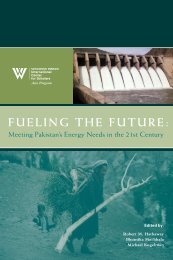Environmental Change and Security Project Report - Woodrow ...
Environmental Change and Security Project Report - Woodrow ...
Environmental Change and Security Project Report - Woodrow ...
Create successful ePaper yourself
Turn your PDF publications into a flip-book with our unique Google optimized e-Paper software.
among countries with responsive decision-makers,<br />
there is too little awareness of the priority of<br />
disaster-risk reduction. One strategy that has<br />
been proposed is to dedicate at least 5 percent to<br />
10 percent of humanitarian relief monies to disaster-risk<br />
reduction. While the precise target should<br />
be resolved by member states, the secretary-general<br />
should take the lead in proposing the establishment<br />
of such a principle. The UN’s Inter-Agency<br />
Task Force on Disaster Reduction (IATF/DR)<br />
<strong>and</strong> the Inter-Agency Secretariat of the<br />
International Strategy for Disaster Reduction<br />
(UN/ISDR) are existing frameworks in which<br />
early-warning systems <strong>and</strong> vulnerability assessments<br />
are already embedded to some degree. 4 In<br />
January 2005, the Second World Conference on<br />
Disaster Reduction will take place in Kobe,<br />
Japan. The parties will review the 1994<br />
Yokohama Strategy on natural disasters <strong>and</strong><br />
establish the disaster-reduction action plan for the<br />
next decade. These processes provide opportunities<br />
to focus more prominently on prevention.<br />
Integrate disaster <strong>and</strong> climate planning:<br />
The UN system needs to integrate concerns<br />
about the consequences of climate change more<br />
fully into its security, natural disaster prevention,<br />
<strong>and</strong> humanitarian response activities; for<br />
example, the UN should make climate change a<br />
more explicit focus of UN/ISDR. In 2003,<br />
UN/ISDR launched a project to do just this,<br />
<strong>and</strong> its progress seems promising. 5 IATF/DR<br />
created a new working group in May 2004 on<br />
climate adaptation <strong>and</strong> disaster reduction, <strong>and</strong><br />
the UN/ISDR Secretariat is coordinating an<br />
expert dialogue among disaster relief, climate,<br />
<strong>and</strong> development communities (UN/ISDR,<br />
2004). As adaptation gains prominence in the<br />
global warming community, however, climate<br />
change bodies are in danger of reinventing the<br />
wheel on disaster prevention <strong>and</strong> response. The<br />
existing network of disaster experts should be<br />
more fully integrated into the IPCC reporting<br />
process to avoid this potential problem.<br />
2. New Strategy Needed for Vulnerable States<br />
While stronger UN early warning <strong>and</strong> disaster<br />
preparedness systems would help predict <strong>and</strong><br />
address disasters, these systems still would not<br />
be entirely adequate to address the most dangerous<br />
security challenges, including massive<br />
migration, armed conflict, <strong>and</strong> state collapse,<br />
which are most likely to occur in undemocratic<br />
<strong>and</strong> weak states. A new multipart strategy is<br />
needed to address these challenges.<br />
Improve early warning systems <strong>and</strong> vulnerability<br />
indices: The UN system needs better tools<br />
for predicting which states <strong>and</strong> regions are most<br />
vulnerable to severe security threats related to climate<br />
change. There is already a proliferation of<br />
early warning systems in the international community<br />
for dealing with different challenges. In<br />
the humanitarian realm, there are numerous systems;<br />
for instance, the UN’s Humanitarian Early<br />
Warning System is an internal UN tool to identify<br />
countries in pre-crisis situations. Reliefweb,<br />
also overseen by the UN’s Office for the<br />
Coordination of Humanitarian Affairs (OCHA),<br />
is an external system that focuses on natural disasters<br />
<strong>and</strong> complex emergencies. At the regional<br />
<strong>and</strong> country levels, OCHA has an Integrated<br />
Regional Information Network, primarily for<br />
sub-Saharan Africa. In agriculture, FAO has the<br />
Global Information <strong>and</strong> Early Warning System<br />
on Food <strong>and</strong> Agriculture, <strong>and</strong> USAID has its<br />
Famine Early Warning System. In terms of<br />
weather-related warning systems, UN<br />
Development Programme <strong>and</strong> UN Environment<br />
Programme/GRID have developed a Disaster<br />
Risk Index, <strong>and</strong> the World Bank <strong>and</strong> Columbia<br />
University have nearly completed a Global<br />
Disaster Risk Hotspots project.<br />
Much of this work is positive. But the<br />
emerging early warning systems in the disaster<br />
reduction community must take political indicators<br />
of vulnerability, such as the repressive<br />
nature of political regimes <strong>and</strong> other governance<br />
factors, more fully into account (Brauch,<br />
2003). In addition, coordination among the<br />
vulnerability indices mentioned above, along<br />
with other early warning systems like the<br />
European Union’s Global Monitoring for<br />
Environment <strong>and</strong> <strong>Security</strong> initiative, is necessary<br />
to st<strong>and</strong>ardize risk assessments in a format<br />
policymakers can use (European Council &<br />
European Space Agency, 2004). The climate-<br />
71<br />
POLICY BRIEF • THE UNITED NATIONS AND ENVIRONMENTAL SECURITY

















